FTA (изд-во). Flexography: Principles And Practices. Vol.1-6
Подождите немного. Документ загружается.


102 FLEXOGRAPHY: PRINCIPLES & PRACTICES
print defects, like dot bridging caused by
dried ink on the printing plate, are all but
eliminated. The inherently higher viscosity
of UV flexo inks aids in reducing dot gain in
process printing and vignettes. Print quality
and consistency is also aided by the lack of
viscosity changes during the press run. UV-
curing equipment is not cheap, but when
examining the comparative cost versus con-
ventional ovens on new presses, the differ-
ences are small.
Two issues seem to concern people the
most about UV inks. First is the question of
safe handling and usage. All inks are chemi-
cals and as such need to be handled with
care. They can’t be eaten or worn, and they
don’t belong in the eyes. Good hygiene is
important when handling any ink. If treated
with the care and healthy respect that chem-
icals deserve, then inks will be able to do the
job they were intended for. The other con-
cern people have expressed or want assur-
ances on is on how to confirm that the UV
ink is cured. There are several cure tests that
can be performed press-side, as well as more
detailed, time consuming tests such as ana-
lytical measurements, which are correlated
to the more simple press-side tests.
ENERGY-CURED PRODUCTS
The following program is recommended
for the safe use of energy-cured formula-
tions and should be applied in the areas of
ink or coating handling, mixing, and cleaning
of equipment. The necessary items should
be readily available to the working area.
Precautions for handling energy-cured inks
and coatings are as follows:
1.Minimize exposure to UV/EB materials.
2. The use of barrier creams for the hands
as a preventive measure is recommend-
ed for those workers who may handle
the products in common, short-term
exposure situations.
3.Glove protection is recommended for
personnel where continuous or long-
term exposure is expected and can not
be avoided. This is particularly true dur-
ing wash-up procedures where solvents
may be in use.
4.It is recommended that some form of
eye protection be available to press-
room personnel and be used around the
pressroom during the working day.
Glasses act as a first-line defense
against accidentally introducing ink,
coating, or wash solvents directly into
the eye. They also reduce the chances
of rubbing the eyes with contaminated
hands. Should ink or coating be acci-
dentally introduced into the eye, flush
with water for at least five minutes and
follow in-plant first aid procedures.
Consult a physician.
5.It is recommended that all personnel
adopt the practice of cleaning ink or
coating off their skin with soap and
water, and not with solvent, which is
the more common practice. Solvent
cleans quicker, but it removes the nat-
ural fats and oils of the skin and may aid
the penetration of the ink and coatings
into the deeper layers of the skin. This
can intensify irritation problems, rather
than helping prevent them.
6.It is recommended that personnel
cleaning large spills of energy-cured
inks or coatings use gloves. In addition,
used wipers from any clean-up should
be placed in a separate container so
that the wiper does not become a
source of additional contamination.
Solvents may be used with care in
cleaning spills on floors and equipment.
7.Keep ink and coating-handling equip-
ment clean and keep used wipers in a
receptacle. This cuts down on inciden-
tal contact to other workers. Keep ink
and coating containers closed.
8.Discourage the practice of eating on the
job or in the work areas and encourage

in every way possible good personal
hygiene.
PROCESS PRINTING
Process color printing is the technique
used to reproduce a subject using yellow,
magenta, and cyan colors, plus black (for
improved contrast). The process is similar
for all printing methods, but varies accord-
ing to ink-metering techniques.
High quality process printing by flexogra-
phy depends on control of the variables in
the process:
Ink Distribution. The evolution in the ink dis-
tribution and metering systems for process
printing has seen a move from the two-roll to
bladed systems, using approximately a 440 to
550 line, 4.0 BCM volume (billion cubic
microns per square inch) chrome anilox, to
ceramic anilox rolls whose line count may be
anywhere from 550 to as high as 1,500 lines
with a cell volume as low as 0.9 BCM. The
improvement in flexo process printing in
recent years can be traced to this evolution in
ink metering and the concurrent change in
flexo plates and inks, as well as printing skill
and techniques.
A typical process cylinder today is 600 to
700 lines, quite possibly at a cell volume as
low as 1.3 BCM. Work is being done at higher
lineage, but this can be difficult. With higher
line count, the cell and cell volumes become
much smaller and ink makers have a difficult
time achieving color strength and staying
open with the very thin ink films. Lower line
counts and higher volumes can be used, but
print quality will suffer as high dot gain and
bridging occur. Problems of this type can
result from too much ink being sent to the
plate from the anilox.
Printing Inks. The new inking systems for
process printing continue to require a con-
stant, easily controllable viscosity. This gen-
erally means Newtonian flow, but also
means that at application viscosity, when
transferring from anilox to plate, the ink
should be relatively short in flow to prevent
bridging and dirty print. Process printing vis-
cosities with bladed metering are 26–29 sec-
onds/#2 Zahn cup. For a given ink, if at 26
seconds the strength is too high, add exten-
der varnish (and often a pigmented exten-
der) to adjust color. Solvent additions will
make the ink too sloppy and cause dot gain
and dirty print.
Applied ink density is a function of the ink
metering system, the ink and its viscosity,
and the operator working together. Most
printers do set up their own color-density
targets, which depend on their equipment,
color separations, and experience. FIRST
(Flexographic Image Reproduction Specifi-
cations & Tolerances) recommended density
targets are shown in Table 17.
Most presses are set up so that colors trap
from light to dark – yellow to magenta to cyan
to black. The yellow may or may not be trans-
parent. All subsequent colors must be highly
transparent, so that light will pass easily
through all ink layers. This sequence may be
true for surface print. Reverse print, on clear
film, is just the opposite, although the basic
principle is the same. As we go to higher inten-
sity ink for thinner ink films, more trans-
parency is critical to obtaining true color and
high contrast. The sequence of inks may
change with different inks and applications.
The key is to remain consistent for a given
process and not change the sequence from
one job to another.
The highest ink viscosity that can be run to
achieve the desired density without dirty
print is optimum. The viscosities given above
are averages. These are several benefits from
higher viscosity printing inks:
• dot gain is minimized;
• printing is sharper, cleaner;
• bridging is reduced; and
• density and contrast values are
improved.
INK 103

104 FLEXOGRAPHY: PRINCIPLES & PRACTICES
Unfortunately, viscosity cannot be in-
creased infinitely. There is a best range.
When it gets too high, dirty printing and off-
setting will be problems. Also, at high vis-
cosities, ink drying can be more difficult to
control and transfer may lag due to ink dry-
ing in the cells of the anilox.
Ink drying in process application is quite
complex. There are three distinct relation-
ships to consider:
• Ink-film Thickness and Drying
• Ink Transfer and Drying
• Ink Viscosity and Drying
The first impression would seem to be: use
the slowest solvent possible and all problems
will be solved. This is not the case. There are
many different slow solvents, and they do
not all have the same effect on ink-film thick-
ness, ink viscosity, and transfer. Some slow
solvents will cause ink film to swell, and ink
viscosity to increase – both these effects tend
to reduce ink intensity and make the job look
weak. Some solvents reduce ink tack; this
also reduces strength and may cause dirty
print. Slow solvents also can cause odor
problems if used to excess. The solution is to
use small amounts (5%–10%) of very slow sol-
vents rather than large amounts of slower
solvents,. Blanket suggestions cannot be
made. The solvents used should be recom-
mended by the ink supplier.
Press Speed. Press speed and the drying
speed of the inks are directly related. In the
earlier presses, color intensity and press
speed were directly related. As press speed
increased, color strength of the applied ink
also increased. The advent of bladed presses
eliminated this problem and today, ink
strength is generally not dependent on press
speed. In chambered-blade systems, if ink
flow into the chamber does not keep up with
press speed, ink starvation can occur, result-
ing in a weak looking print. In addition to con-
cern with the ink metering, a press set-up at
300 fpm may require resetting of impressions,
when higher running speeds (say 900 fpm)
are used, in order to maintain color densities.
Plates. Good process printing depends on
achieving a light kiss impression between the
anilox and the plate. Too much impression
can show up as weakness, fast drying, and
dirty print. A kiss impression must be main-
tained between plate and substrate as well, or
the dots printed will be misshapen and the job
will look weak and dirty as ink piles up in the
wrong places on the printing plate.
Substrates. Another variable that must be
dealt with in process printing is the substrate.
Due to the transparent nature of process
inks, the finished appearance and colors of a
given job are highly dependent on the color
and smoothness of the substrate. Any color
in the substrate will appear in the printed ink
area. The color must be adjusted by means of
the separations or by using a first-down white
to hide the substrate color. Poor substrate
smoothness, or anything on the substrate
that will negatively affect ink transfer, will
create problems and sometimes these can be
cured using a first-down varnish or white.
Higher ink viscosities can sometimes help,
but often these cause other problems.
Press Characterization
To determine how each of the print vari-
ables come together to create a finished
halftone color process print, a press charac-
terization or “fingerprint test” of the printing
process is carried out by the actual press
Table 17
PAPER FILM
■ CYAN 1.28–1.42 1.18–1.32
■ MAGENTA 1.18–1.32 1.13–1.27
■ YELLOW 0.95–1.05 0.95–1.05
■ BLACK 1.43–1.57 1.33–1.47
* Flexographic Image Reproduction Specifications and
Tolerances
FIRST* SOLID INK DENSITY

crew. The test should reflect actual day-to-
day operating conditions and optimum press
performance. FIRST contains specific guide-
lines as to how the press characterization
process should be conducted, including a
test target (Figure
7(
). During the character-
ization, the printing parameters for the indi-
vidual press conditions will be established.
Controlling the Print. Using a densitometer,
the solid ink densities should be checked.
Color strength can be adjusted by adding
extender (to lower density) or toner (to raise
density) to bring color density to within
specificatons. The printed sheet should be
inspected carefully. Any obvious print prob-
lems (slur, uneven print, over-impression,
moiré, etc.) should be corrected at this
stage. All pertinent data should be recorded,
including:.
• plate type and thickness;
• viscosity of ink;
• density of ink;
• Anilox cell count and volume;
• impression settings;
• blade pressure; and
• press speed.
Interpretation of Print Results. There are sev-
eral ways to interpret the printed result:
• visually;
• microscopically (microscope with
scale);
• densitiometrically (color densitometer);
and
• spectrophotometrically (spectropho-
tometer).
The human eye is a very sensitive color
measurement device. Unfortunately, visual
sensitivity is based on comparisons of color
hue shifts or densities over time, which the
brain has no way of accurately recording.
The modern reflection densitometer is an
invaluable tool for the process printer. It
allows communication in numerical values by
simplifying the process of establishing refer-
ence standards for predictable results.
Making halftone process printing an every-
day reality is greatly aided when the human
element of color evaluation is reduced. As
subsequent density readings are taken, shifts
in hues or densities may be noticed and cor-
rections can be made in the ink or press set-
tings to reestablish the target readings.
Using a spectrophotometer enables pro-
cess printing to be controlled using color
measurements as the human eye perceives
color. More details are covered in the Process
Printing chapter.
The following observations and records
should be taken every time a halftone
process color job is printed.
Printing Quality. First, the print evaluator
should visually examine the print and the
printed target to make sure it is the best
achievable result. The targets should be
sharp, free of unwanted printing between
dots and lines, and in tight register. There
should be no dot deformation such as, slur-
ring, moire, or gear marks. Using a densito-
meter, solid ink densities should be mea-
sured to assure they meet specifications.
Dot Gain and Tonal Range. Selected screen val-
ues for each color are read with a densito-
meter. These readings may be converted to
dot percentages using the Murray-Davis for-
mula built into the microprocessor of the
densitometer. These readings provide impor-
tant information on dot growth and tonal
reproduction.
Gray Balance. Gray balance targets are three-
color overprints of cyan, magenta and yel-
low, balanced to appear neutral or gray. They
are typically placed next to a patch of black
with the same visual tone value. This pro-
vides for an extremely sensitive visual con-
trol on the printing process since the eye is
very sensitive to slight shifts in color from a
neutral gray. The gray balance targets are
typically composed of shadow, midtones
and quarter-tones. Gray balance targets can
also be measured using either a densitome-
INK 105
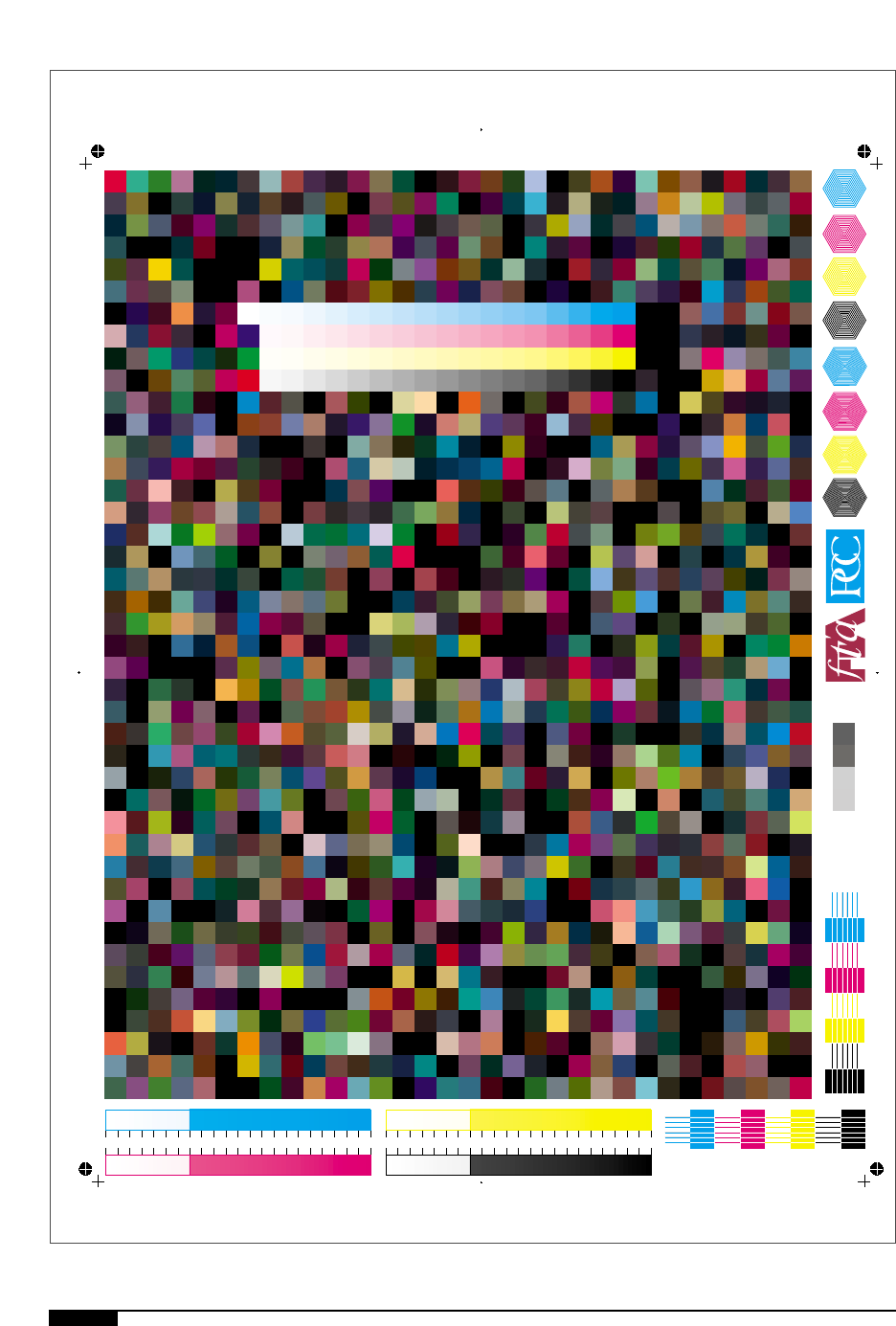
106 FLEXOGRAPHY: PRINCIPLES & PRACTICES
M
C
Y
K
M
C
Y
K
123456789101112131415161718192021222324252627282930313233343536373839404142
ABCDEFGHI JKLMNOP
3Electronic File Values 5 10 15 20 25 30 35 40
QRSTUVWX
45 50 55 60 70 80 90 100
3Cutback Values (film) 5 10 15 20 25 30 35 40 45 50 55 60 70 80 90 100
Y Z AA BB CC DD EE FF
0 2 4 6 86 88 90 92 94 96 98 100 0 2 4 6 86 88 90 92 94 96 98 100
7(

ter or spectrophotometer and the values
compared against the values obtained at the
press characterization.
For high quality process color reproduc-
tion, the information from the press charac-
terization or fingerprint test, should be used
to produce repeatable results. The separa-
tions developed from the test will work best
only for the printing conditions established
during the test. Ink densities, viscosities,
metering, and the other general press condi-
tions must be maintained during production.
PRESS APPROVALS
When a job is printed, there are several
properties that must be checked on a con-
tinuous basis. These include print quality,
ink adhesion, color, strength, print register,
etc. The following sections describe some of
the more common properties that should be
checked press side during a run.
Print Quality
When a job is printed, the overall print
quality must be checked. This would include
sharpness of fine type and reverse-outs, ink
lay, ink gloss–and in process printing, overall
dot structure. Along with print quality, it
should also be noted that all colors are being
printed in the proper trap sequence. This
would also include ensuring that the correct
colors are in each of the printing decks. A
job should also be inspected to ensure that
there are no spelling errors, missed words or
logos, and that all the colors, primers, and/or
overprints are being printed. On more than
one occasion, jobs have been printed where
a color was accidentally left off the job.
Details of the following tests were covered
in other parts of this volume.
Ink Adhesion
Ink adhesion is perhaps the most common
press-side test done. It is also one of the
most powerful diagnostic tools. An ink-adhe-
sion test should be performed at the begin-
ning of each roll of printed material. Poor
tape adhesion can be the result of any of the
following:
• Wrong side of the film was printed.
• The wrong film is in the press.
• The film has insufficient treatment to
allow acceptable ink adhesion.
• Dryer temperatures are insufficient.
• The wrong ink is in the press.
Ink Color
When printed colors, including white are
printed and evaluated, the hue, chroma, and
lightness should be measured using a spec-
trophotometer. As well as a visual assess-
ment, an objective color measurement
should be performed on all colors of a job to
ensure consistency and acceptability to a
standard. Spectrophotometers are used to
measure the amount of light reflection in the
visible color spectrum. These spectral
curves are much like fingerprints of a color.
They provide a numeric representation that
eliminates the subjective factors associated
with visual assessment. It is possible to have
a metameric color match when the two col-
ors being compared use different pigments.
A metameric match occurs when two colors
match under one set of lighting conditions
but not under another. For example, the col-
ors can match when viewed in a light booth
under standard light (D50) but will not
match under incandescent lighting. The
measurement of color by a spectrophotome-
ter allows for identification of metameric
color matches by reading color under vari-
ous lighting conditions.
Ink Strength or Opacity
The transparency or opaqueness of a color
should also be compared to a standard. The
level of transparency becomes important
when printing on nonopaque substrates,
over high gloss or metallic substrates, and in
INK 107
7(
(opposite page)
FTA Press
Characterization Target.
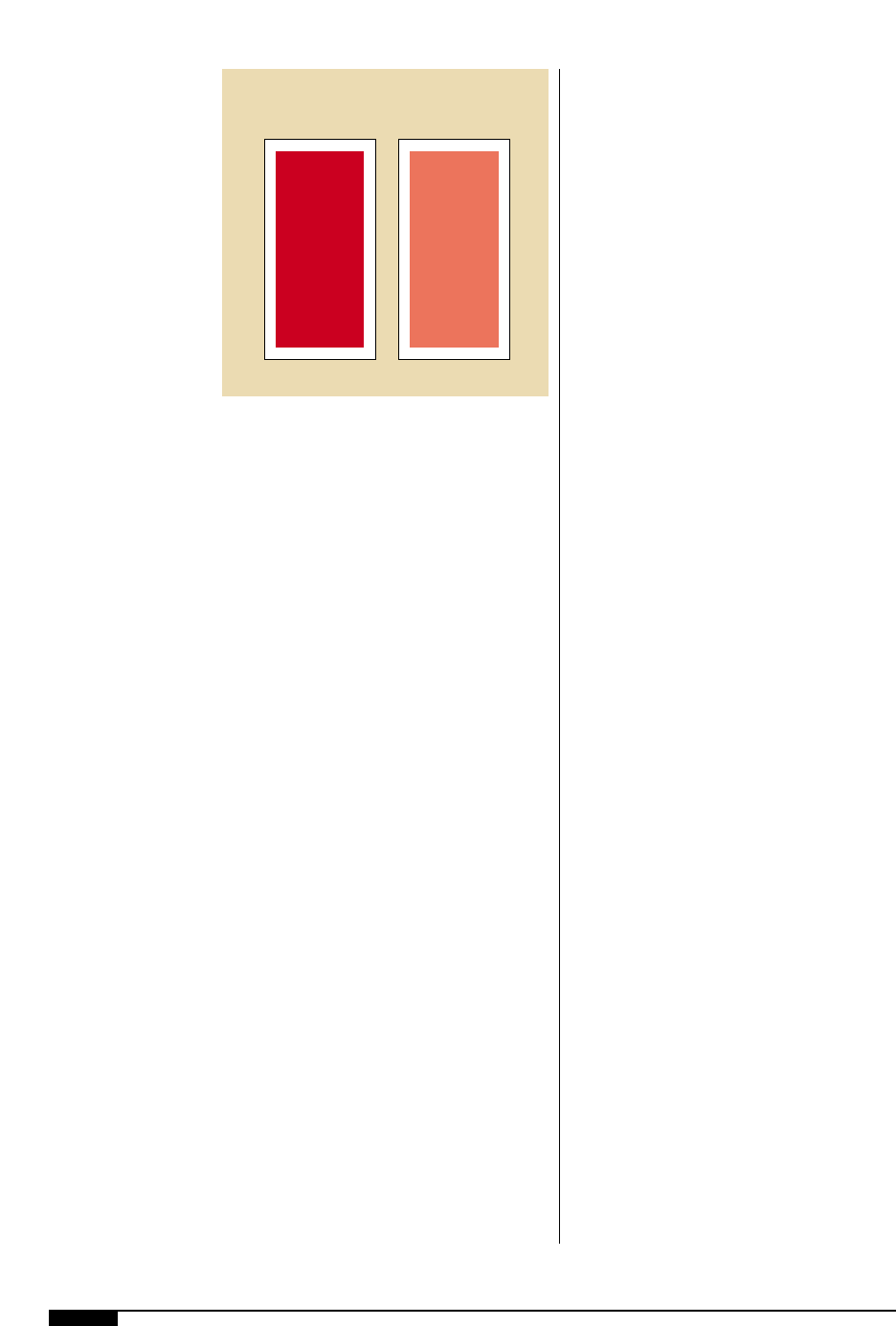
108 FLEXOGRAPHY: PRINCIPLES & PRACTICES
resulting colors from multiple ink traps.
Opacity is commonly assessed visually. The
level of opacity in a white ink can be deter-
mined objectively by the use of an opacime-
ter. The level of strength that an ink print
exhibits can also affect its color. Certain col-
ors will actually appear a different shade as
the color becomes weak or strong vs. a stan-
dard. An example of this would be a Rubine-
based color match (Figure
8)
). As the ink
strength becomes weaker, the color appears
to be more yellow. Color strength is often
assessed visually and subjectively. A densit-
ometer or spectrophotometer can also be
used to monitor the strength of the ink. A
weaker ink will have a lower density and dif-
ferent, lighter color.
Before color adjustments are made press
side, correct strength should be obtained.
This will avoid the possible addition of col-
ors that can make the match difficult to con-
trol and can result in metamerism.
Scratch Test
A quick test for scratch resistance during
start-up and press run can identify some
potential problems easily and quickly. If an
ink contains wax additives and the container
of ink was not mixed properly, it is possible
the scratch resistance will be poor. The test
is performed by taking the back of the fin-
gernail and dragging it across the surface of
the print. The scratch resistance comparison
vs. standard is necessary, due to the highly
subjective method involved (Figure
8!
).
If ink is removed vs. standard, the situation
should be investigated.
Print Register
When running more than one color on a
job, each color must be printed in close posi-
tional relationship to the other colors on the
job. This relationship is called register. If the
press causes the substrate to stretch beyond
acceptable limits or oven temperatures are
too high and cause the substrate to shrink,
register can go out of acceptable limits. Both
of these problems are usually correctable by
press adjustments.
A job can also be out of register if the
mounting of the plates on the plate cylinder is
not done properly. If the register at the left
lead edge of the print is in register and the
right trail edge is out of register, it is likely
that one of the plates may be mounted incor-
rectly. When a job is out of register due to
plate-mounting problems, the plates will need
to be remounted to correct the problem.
Ink Gloss
Gloss is a measure of the degree of
reflectance on the surface of the print
(Figure
8@
). The gloss level of a print is most
commonly measured visually versus a stan-
dard. There is a move toward the use of a
glossmeter to eliminate the subjective visual
interpretation and to allow for numeric
determination of gloss. If the gloss level is
unacceptable, it may be an indication that
the ink printed has not been mixed properly.
This can cause an inconsistent level of slip
additives in the ink container. The higher
level of these additives can decrease gloss.
Ink Crinkle
On flexible packaging materials, such as
polyethylene, polypropylene, polyester, etc.,
8)
Strong vs. weak ink test.
Color strength is
often assessed visually
and subjectively. A
densitometer or
spectrophotometer can
also be used to monitor
the strength of the ink.
Strong Weak
8)
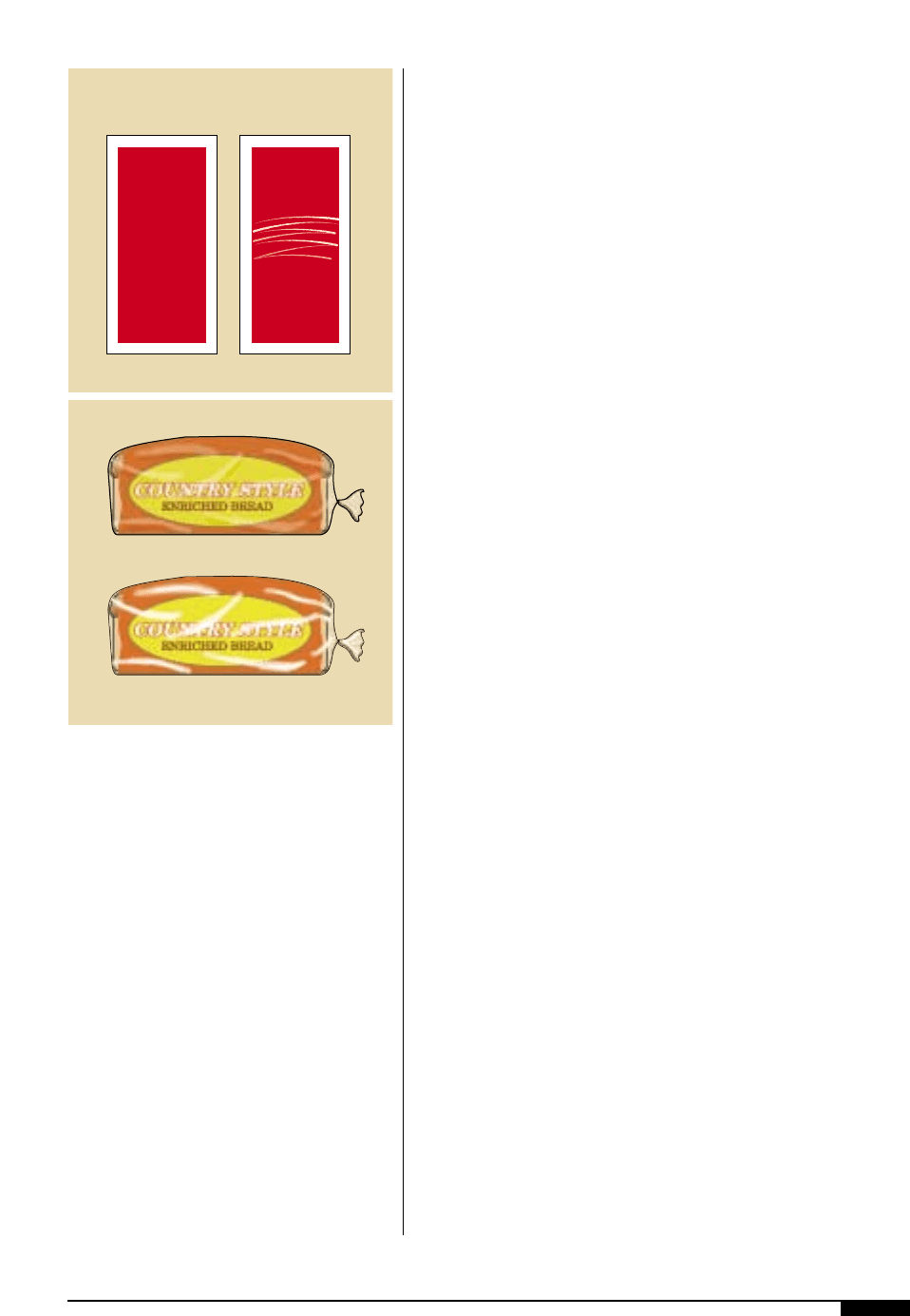
inks must also have acceptable flexibility.
Poor flexibility on these substrates can
result in ink flaking off the package as it is
handled. Prints are most commonly checked
for flexibility by putting about an inch of
print material between the thumb and fore-
finger of each hand and quickly rotating the
prints several times. This is a very subjective
test. The number of times the prints are
rotated and the degree of force in that rota-
tion will affect the results. It is therefore ben-
eficial to do this test with a known accept-
able print and compare those results to the
production print (Figure
8#
). There are also
instruments available for determining the
degree of ink flexibility. These instruments
provide a much more consistent method of
testing to allow for greater repeatability.
Lamination Green Bonds
When a job is laminated, it is important
that bond levels be checked off the press to
ensure that the process is in control. When
adhesive lamination is done, bonds typically
improve over time as the adhesive cures.
Bond levels are determined by taking a 1-
inch wide strip of laminated material and
measuring the force needed to split the two
laminated films apart. It is also important to
note where the failure of the bond occurs.
The point of delamination can indicate if the
ink, adhesive, film, or application method is
the cause of low bonds. The ultimate goal is
to obtain stock destruction.
Coefficient of Friction
Certain packages require a specific level of
slip on the outside and often the inside of the
package. The inside slip level is important
for high speed filling operations, where the
product must go into the package. An
inclined plane or an AGR are two common
instruments used to measure the Coefficient
Of Friction of a surface. Tests are usually
done at the start of a production run and
checked at regular intervals during the run
to be sure the process is in control.
Rub
When rub resistance is required, it is com-
mon to test the rub resistance of the print
either against itself or against another surface
the print will be in contact with (Figure
8$
).
The test is carried out using a Sutherland rub
tester as described in Chapter 1. This test is
performed with a certain amount of weight
applied to the print for a set number of
strokes/rubs in contact with either the print
or the expected contact surface. In addition
to the Sutherland rub tester, there are other
instruments that can be used to test rub resis-
tance, depending on the shipping and storage
conditions a package will be exposed to. It is
not unusual for optimum rub resistance prop-
erties to develop over several hours.
INK 109
8!
Good scratch vs. bad
scratch test. If an ink
contains wax additives
and the container of ink
was not mixed properly,
it is possible the scratch
resistance will be poor.
8@
Flat vs. gloss ink.
If the gloss level is
unacceptable, it may be
an indication that the
ink printed has not been
mixed properly.
Good Bad
8!
Flat means stale
Gloss means fresh
8@
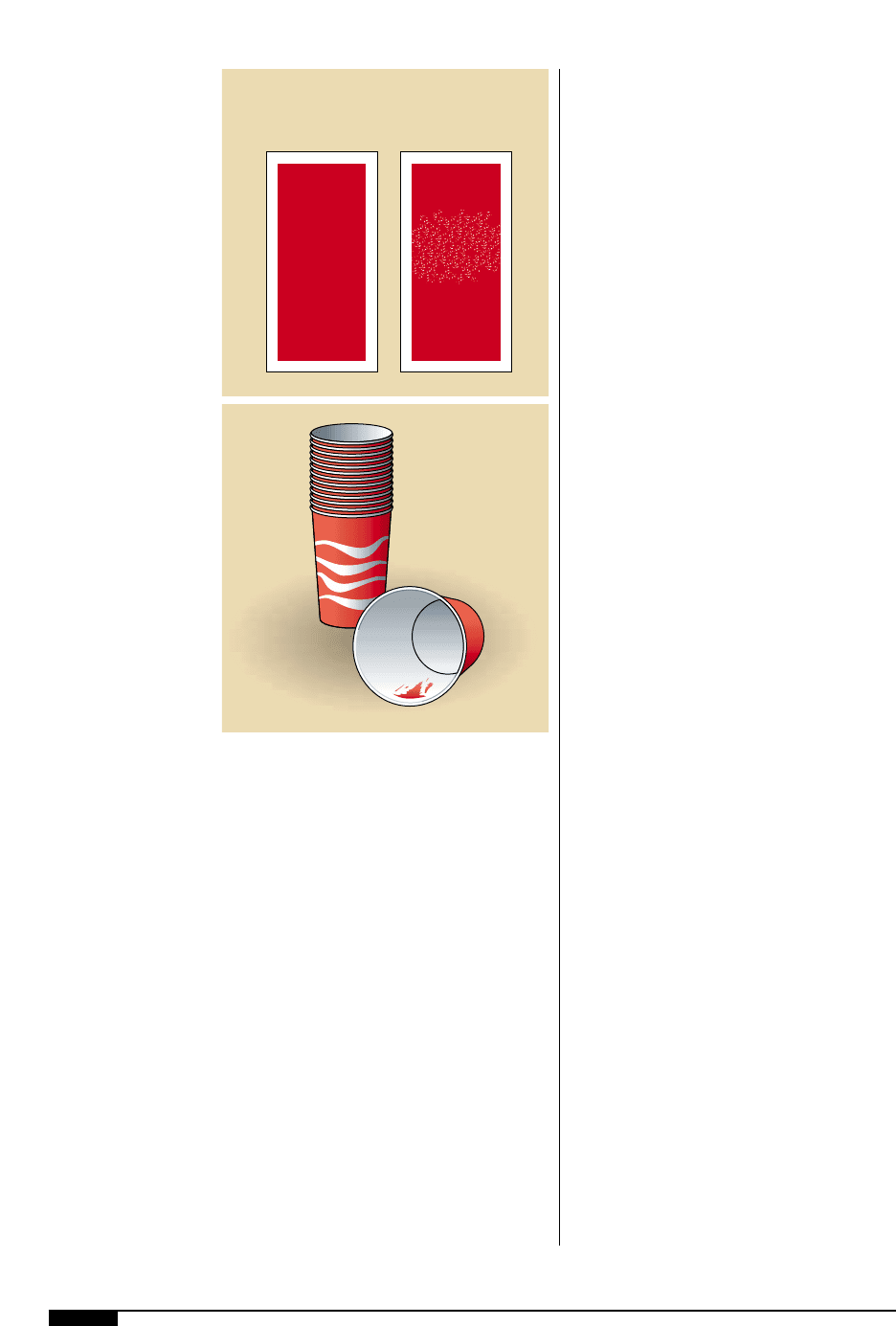
110 FLEXOGRAPHY: PRINCIPLES & PRACTICES
Water Resistance
If a print is expected to be in contact with
water, the inks must be designed to resist any
bleeding or removal during this exposure.
This is especially important for water inks;
however, solvent inks may be of concern
also. The degree that an ink will bleed in
water is largely a function of the colorant
used. If an incorrect pigment was used to
tone the ink press side, the resulting print
may bleed when exposed to water. This can
happen with both solvent- and water-based
inks. Test methods for water resistance are
specific to the particular application in-
volved. They must be agreed to by all parties
involved in the process.
Water-based inks have their own concerns
when it comes to water resistance. Commer-
cial water-borne inks are not soluble in water,
but rather in amine and water. If a job is print-
ed and the amine is not removed through dry-
ing, or if too much or the wrong amine was
added to an ink, the printed material may res-
olubilize when exposed to water. Generally,
water resistance improves with time when
water-based inks are printed. With the
increased use of water-borne inks, some print-
ers have set up tests off press to check for
water resistance. This is done by wiping the
print a number of times with a wet tissue. The
pressure and amount of water used, as well as
the number of wipes made will all affect the
results. Once these three variables are con-
trolled, this test can be a good indicator that
the inks were applied and dried properly.
Other Conditions
It would be difficult to anticipate all possi-
ble conditions that may require press side
testing. It is perhaps best to realize that any
job should be carefully reviewed to deter-
mine which testing is feasible to be done
press side. This can be determined by using
a team approach to review what conditions
the package will be exposed to and how the
package is designed to perform.
SUBSTRATES
If a printer was asked what one thing he
would like to see from his ink company, he
would likely answer “one ink which works
on all the substrates” (Figure
8%
). There are
many ink systems out there, because there
are many substrates printed flexographically,
which is why the process is so popular. Each
substrate has unique characteristics which
require different formulations of inks in
order to get the end-use properties desired in
the final package. Common substrates that
inks are specifically formulated to print on
are papers and paperboards, polyethylenes,
foils, cellophanes, vinyls, polypropylenes,
PVCs, coextruded films, polyesters, metal-
8#
Good crinkle vs. bad
crinkle. For flexible
packaging materials,
inks must also have
acceptable flexibility.
Poor flexibility on these
substrates can result
in ink flaking off the
package as it is
handled.
8$
It is common to test the
rub resistance of the
print against itself or
against another surface
the print will be in con-
tact with.
Good Crinkle vs Bad Crinkle
Good Bad
8#
8$
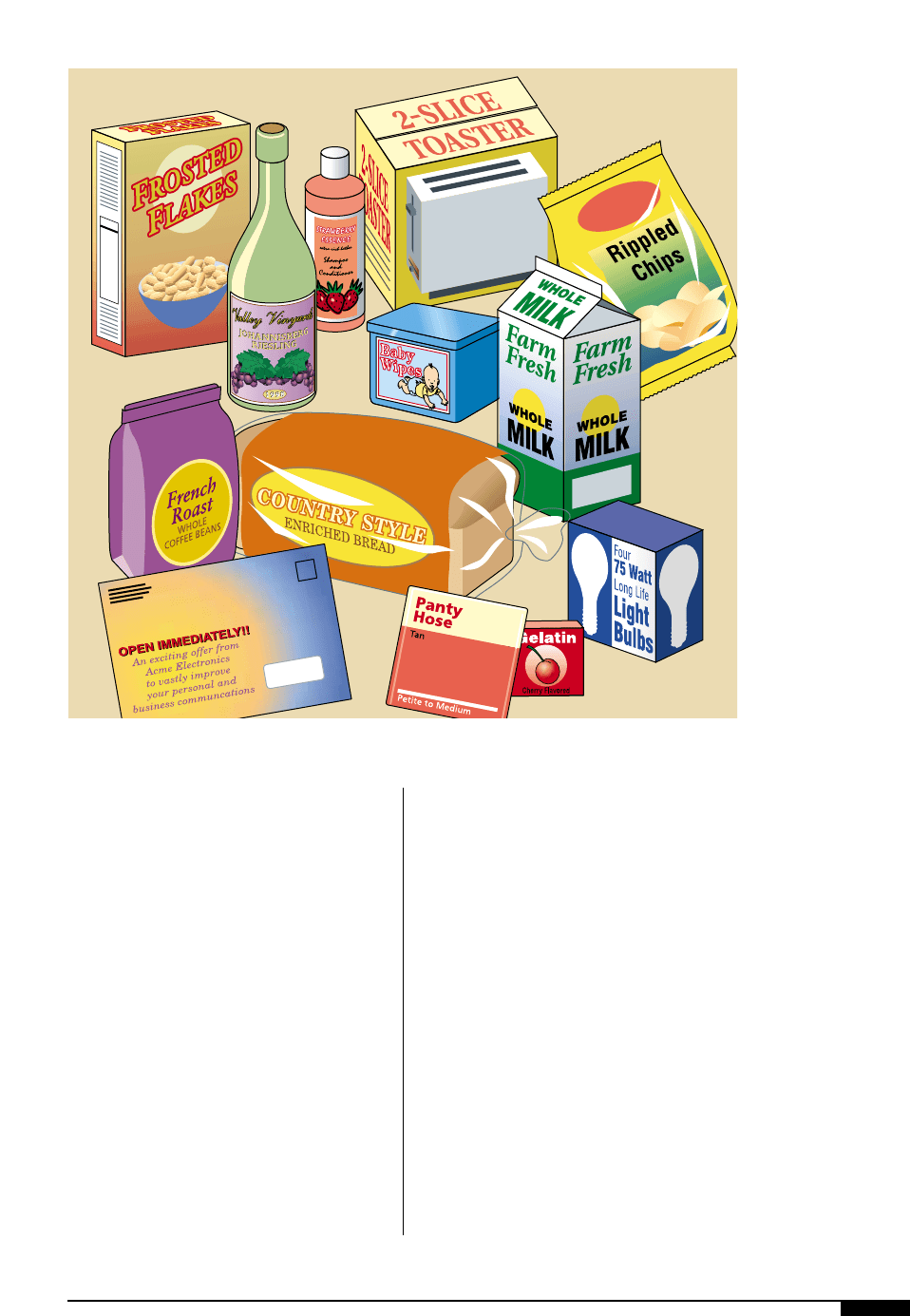
lized films and more being introduced to the
process. Each of these substrates has varia-
tions, depending upon manufacturer and
production processes. Each variation could
require a different ink system, or maybe a
slight modification to an existing ink.
It is important to remember that as sub-
strates vary, the inks often have to vary with
them. For example, if a printer is using a
polyester film and switches to another poly-
ester, which is supposed to be the same,
there is a chance that the same ink will not
work equally well on both substrates. The
ink industry saw this problem recently.
Polyester film suddenly became difficult to
obtain in one part of the world. Some print-
ers bought overseas products which were
supposedly equal to what they had previous-
ly purchased. It was realized that this was
not the case, when their standard polyester
ink systems did not work properly on the
imported substrate. In some cases, before
the ink companies could formulate an ink to
work on the imported material, the polyester
shortage was over and printers could again
purchase the material they originally used.
The point to remember is that if someone
asks you what type of ink should be used on
a specific polypropylene film, don’t be too
quick to respond unless you are familiar
with that exact substrate.
Substrate’s Effect on Color
When color matching, it is very important
to match the color of the ink applied to the
substrate on which it will be printed. The
INK 111
8%
Paper, paperboard,
corrugated board,
polyethylene, vinyl,
cellophane, polypropy-
lene, PVC film and foil
represent several of the
different classifications
of substrates that be
utilized in the flexo-
graphic printing
process.
B
O
B
’S
8%
